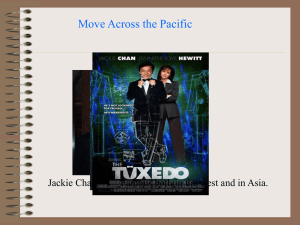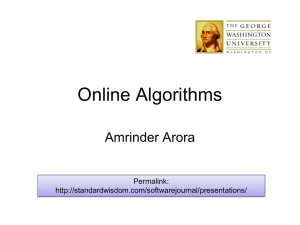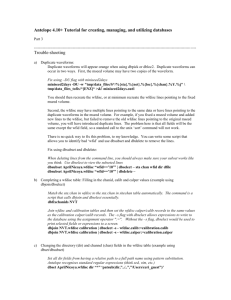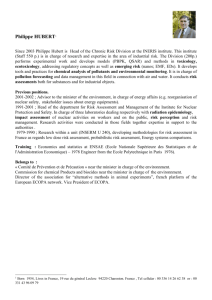PPT - Department of Computer Science, HKU
advertisement
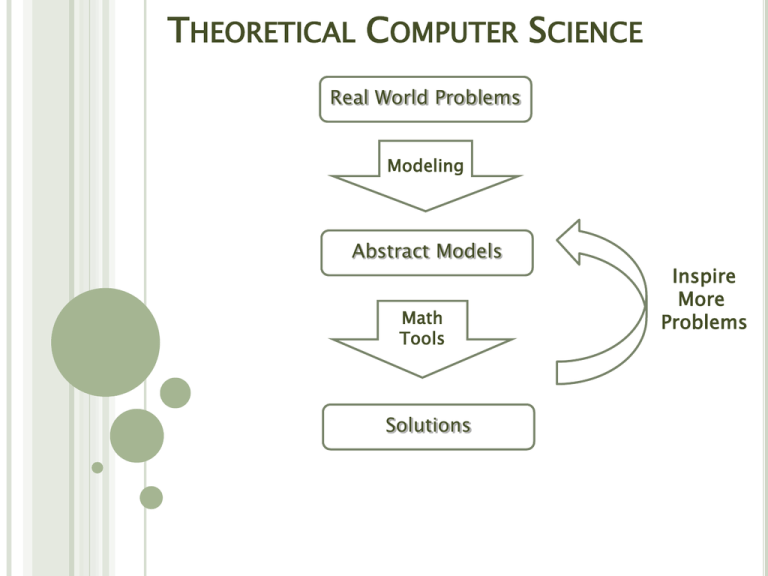
THEORETICAL COMPUTER SCIENCE Real World Problems Modeling Abstract Models Math Tools Solutions Inspire More Problems CAREER DIRECTIONS College Study Algorithms Research Institute Industry Network Algorithm Team Hubert Chan Postgraduates: Li Ning 宁立 Fei Chen 陈飞 Mingfei Li 李明飞 Xiaowei Wu 吴晓伟 Natural Algorithm: to Achieve Consensus 2 3 3.3 3.1 4 3 5 3 2.6 3.1 5 3 4 3 3.3 3.3 3.1 5 3 2.6 2.9 2 3 3.1 2.7 3 2 3 3.4 3 2.9 1 3 Observation: An individual’s opinion will be Researcher: kind of natural behavior is by influencedThis by its friends/neighbors. Inmodeled some cases, dynamic systems. By our results, it is very fast for people people will achieve a consensus finally, even when to achieve consensus even under dynamic networks. their neighborhoods keep changing. “Fast convergence for consensus in dynamic networks”, Hubert Chan, Li Ning, ICALP 2011. 2.9 1 3 Spanners: “Building the Roads” Government: We need roads to connect cities, and weResearcher: want save theThis cost.is a spanner problem. Traveler: roads should save time. Use our Travelling methods,along thenthe you don’t need many roads, and travelling distance along the roads is almost the same with travelling directly. “Sparse fault-tolerant spanners for doubling metrics with bounded hop-diameter or degree”, Hubert Chan, Mingfei Li, Li Ning, ICALP 2012. Information Spreading in Social Networks News… All my friends are Not talking a big about deal this news News… News… News… News… News… Not a big deal Observation: People will spread information, e.g., news, via talking to their friends. Moreover, the news talked by more friends attract more attention. Advertiser: Persuade one person, then he will spread Researcher: To spread information efficiently, which the advertisement… person should be picked initially? … “Maximizing influence in information networks under the non-progressive linear threshold model”, Hubert Chan, Li Ning, ongoing project. Bargaining Good. I’ll pay less... I’ll pay 50. 40. I’ll pay 40. I’ll pay 40. I have to pay more… I’ll pay 50. 60. I’ll pay 30. I’ll pay 45. I’ll pay more... I’ll pay 40. 60. Rent sharing: The total cost to rent a flat is 100. It can be shared by two persons. Researcher: This is studiedHuman as the behavior problem is called Sociologist: so complicated. bargaining game. What are the stable deals? “Optimizing Social Welfare for Network Bargaining Games in the Face of Unstability Greed and Spite”, Hubert Chan, Fei Chen, Li Ning, ESA 2012. ONLINE ALGORITHMS: JOB SCHEDULING & POWER MANAGEMENT Scheduling research team: T.W. Lam 林德华 H.F. Ting 田慶豐 H.L. Chan 陳昊樑 L.K. Lee 李立基 S.H. Chan R. Li ONLINE PROBLEMS ARE CHALLENGING. Broadcasting Scheduling Paging Deadline Bin Packing Trading Load balancing Response Flow time Robot motion Without knowing the future, one often makes the wrong decision. “What matters most to the computer designers at Google is not speed, but power, low power, because data centers can consume as much electricity as a city.“ Eric Schmidt, CEO Google NY Times, 2002 REPRESENTATIVE PUBLICATIONS Sleep Management on Multiple Machines for Energy and Flow Time. ICALP 2011: 219-231 Non-clairvoyant Speed Scaling for Weighted Flow Time. ESA 2010: 23-35 Sleep with Guilt and Work Faster to Minimize Flow Plus Energy. ICALP 2009: 665-676 Speed scaling with an arbitrary power function. SODA 2009: 693-701 Scheduling for Speed Bounded Processors. ICALP 2008: 409-420 Energy efficient online deadline scheduling. SODA 2007: 795-804 BIOINFORMATICS F. Chin T.W. Lam H.F. Ting S.M. Yiu Bioinformatics involves the analysis of biological and genetic information, the results of which can then be applied to gene-based drug discovery and development to cure illnesses Our objective is to develop better software tools to aid bioinformatics research. Next Generation Sequencing NGS is the new & cornerstone technology for today’s biological research and tomorrow’s medical care. Nowadays NGS equipment (Solexa, SOLiD, Illumina) can produce short fragments (read) of a DNA sequence (genome) efficiently and at a low cost. Our research work is to base on our algorithmic expertise to develop efficient and effective software tools for NGS data. Research Publications and Funding Publications: Bioinformatics, J of Computational Biology, RECOMB, ISMB, ECCB GRF Grants Structural Alignment and prediction for non-coding RNAs with triple helix structure (2011-2014, HK$681,195) Algorithms for Inferring k-articulated Phylogenetic Network (2009-2012, HK$591,080) Combinatorial Phenotype Testing (2009-2012, HK$394,053) Finding Conserved Patterns In Biological Networks (2008-2012, HK$777,108) A New Motif Representation Based on Position Specific Patterns (2006-2009, HK$775,008) Compressed Indexes for Approximate String Matching, with Applications to Biological Sequences (2006-2008, HK$654,000) Design and Analysis of Algorithms for Constrained Structure Comparison (2006-2008, HK$612,816) Computationally Haplotyping Pedigree Data (2005-2007, HK$359,224) Algorithms for Uncovering Conserved Genes on Whole Genomes (2004-2007, HK$650,000) Programming Programming Languages Languages Programming languages research team: B. C. d. S. Oliveira X. Bi H. Zhang PROGRAMMING LANGUAGES ARE FUNDAMENTAL TO PROGRAMMER PRODUCTIVITY PROGRAMMING LANGUAGE RESEARCH AIMS AT: - ALLOWING FASTER DEVELOPMENT CYCLES - SUPPORTING LARGE-SCALE PROGRAMMING - PREVENTING MORE BUGS CREATING NEW PROGRAMMING LANGUAGES/ABSTRACTIONS BY RESEARCH TOPICS - BETTER PROGRAMMING MODELS COMPUTING, GPU PROGRAMMING - BETTER MODULARITY SCALE SOFTWARE FOR MULTI-CORE ABSTRACTIONS FOR LARGE- - FUNCTIONAL PROGRAMMING (SCALA, HASKELL, OCAML, SCHEME …)





